Two Sets of High-Conductivity Systems with Different Scales Reveal the Seismogenic Mechanism of Earthquakes in the Songyuan Area, Northeastern China
Abstract
:1. Introduction

2. Regional Tectonic Setting
3. Data Acquisition
4. Data Analysis
5. 3D Inversion
6. Interpretation and Discussion
6.1. Shallow Low-Resistivity Fault
6.2. Deep Low-Resistivity Fluid
6.3. The Seismogenic Mechanism in the Songyuan Area
7. Conclusions
- (1)
- The Fuyu North fault is a shallow seismogenic structure in the Songyuan area. In addition, the deep part of the North Fuyu fault is north-dipping, which is different from the south-dipping part, as demonstrated in previous research.
- (2)
- There is a low-resistivity anomaly in the deep part of the Songyuan area, directly leading to the asthenosphere, which is the upwelling mantle material. This provides a power source for the accumulation and release of stress above.
- (3)
- The seismogenic mechanism of the Songyuan area is mainly characterized by a deep shallow interaction, which can be specifically described as follows: There are two sets of high-conductivity systems with different scales. The deep high-conductivity system corresponds to magma upwelling, while the shallow high-conductivity system corresponds to fault activation. The vertical action of thermal material from the upper mantle provides the power source for the Songyuan area: the molten material underplates to the lower crust, accumulating and invading along the fault, leading to the activation of the North Fuyu fault and inducing the Songyuan earthquake.
Author Contributions
Funding
Data Availability Statement
Acknowledgments
Conflicts of Interest
References
- Yang, Y. Deep Electrical Structure and Seismogenic Mechanism in Seismic Active Area of Songyuan. Ph.D. Thesis, Jilin University, Changchun, China, 2019. (In Chinese). [Google Scholar]
- Yang, H.D.; Yao, P.; Zhang, X.; Liu, L.; Yang, Y.C.; Wang, C.J. Distribution of Inorganic Carbon Dioxide in Southern Songliao Basin. Nat. Gas Geosci. 2008, 5, 634–638. (In Chinese) [Google Scholar]
- Jiang, G.Z.; Gao, P.; Rao, S.; Zhang, C.Y.; Tang, X.Y.; Huang, F. Compilation of heat flow data in the continental area of China (4th edition). Chin. J. Geophys. 2016, 59, 314. (In Chinese) [Google Scholar] [CrossRef]
- Weng, A.H.; Tang, Y.; Li, Y.B.; Yang, Y. Magnetotelluric image of fluid-induced Songyuan earthquake. Recent Dev. World Seismol. 2019, 8, 124–125. (In Chinese) [Google Scholar]
- Han, J.T.; Guo, Z.Y.; Liu, W.Y.; Hou, H.S.; Liu, G.X.; Han, S. Deep dynamic process of lithosphere thinning in Songliao basin. Chin. J. Geophys. 2018, 61, 95–109. (In Chinese) [Google Scholar]
- Zhao, G.Z.; Unsworth, M.J.; Zhan, Y.; Wang, L.F.; Chen, X.B.; Jones, A.G.; Tang, J.; Xiao, Q.B.; Wang, J.J.; Cai, J.T.; et al. Crustal structure and rheology of the Longmenshan and Wenchuan Mw 7.9 earthquake epicentral area from magnetotelluric data. Geology 2012, 40, 1139–1142. [Google Scholar] [CrossRef]
- Gardonio, B.; Jolivet, R.; Calais, E.; Leclère, H. The April 2017 Mw6. 5 Botswana earthquake: An intraplate event triggered by deep fluids. Geophys. Res. Lett. 2018, 45, 8886–8896. [Google Scholar] [CrossRef]
- Stein, S.; Liu, M. Long Aftershock Sequences within Continents and Implications for Earthquake Hazard Assessment. Recent Dev. World Seismol. 2009, 12, 7–11. [Google Scholar] [CrossRef]
- Stephenson, R.; Egholm, D.L.; Nielsen, S.B.; Stovba, S.M. Role of thermal refraction in localizing intraplate deformation in southeastern Ukraine. Nat. Geosci. 2009, 2, 290. [Google Scholar] [CrossRef]
- Wang, X.F.; Yu, S.; Li, S.Z.; Ma, Y.; Zhao, S.J.; Liu, X.; Dai, L.M. Comparison of active structure and earthquake triggering mechanism between plate margin and plate interior. Mar. Geol. Quat. Geol. 2014, 34, 159–175. (In Chinese) [Google Scholar]
- Shen, J.; Shao, B.; Yu, X.H.; Yu, Y.; Qi, G.; Deng, M.; Zhang, H. Seismogenic tectonics of the Qian-gorlos earthquake in Jilin Province, China. Earthq. Sci. 2016, 29, 93–103. [Google Scholar] [CrossRef]
- Xue, L.F.; Zhu, M.; Li, W.Q.; Liu, W.Y.; Liu, Z.H.; Liu, Z.Y. Earthquake Triggered by “Magma Bubble” Bursting: 2013 Songyuan Earthquake Cluaters in Jilin as an Example. J. Jilin Univ. (Earth Sci. Ed.) 2018, 48, 1865–1875. (In Chinese) [Google Scholar] [CrossRef]
- Tang, Y.; Weng, A.H.; Yang, Y.; Li, S.W.; Niu, J.J.; Zhang, Y.H.; Li, Y.B.; Li, J.P. Connection between earthquakes and deep fluids revealed by magnetotelluric imaging in Songyuan, China. Sci. China Earth Sci. 2021, 64, 161–176. [Google Scholar] [CrossRef]
- Buttinelli, M.; Improta, L.; Bagh, S.; Chiarabba, C. Inversion of inherited thrusts by wastewater injection induced seismicity at the Val d’Agri oilfield (Italy). Sci. Rep. 2016, 6, 37165. [Google Scholar] [CrossRef] [PubMed]
- Lopez-Comino, A.J.; Cesca, S.; Jarosławski, J.; Montcoudiol, N.; Heimann, S.; Dahm, T.; Lasocki, S.; Gunning, A.; Capuano, P.; Ellsworth, W.L. Induced seismicity response of hydraulic fracturing: Results of a multidisciplinary monitoring at the Wysin site, Poland. In Proceedings of the 20th EGU General Assembly, EGU, Vienna, Austria, 4–13 April 2018; p. 8307. [Google Scholar] [CrossRef]
- Hill, G.J.; Caldwell, G.; Heise, W.; Cas, R.A.F.; Cull, J.P.; Bibby, H.M.; Burgess, M.K. Imaging magmatic systems using magnetotelluric data: Mount St. Helens and Mount Adams. Nat. Geosci. 2009, 2, 785–789. [Google Scholar] [CrossRef]
- Wannamaker, P.E.; Caldwell, T.G.; Jiracek, G.R.; Maris, V.; Hill, G.J.; Ogawa, Y.; Bibby, H.M.; Bennie, S.L.; Heise, W. Fluid and deformation regime of an advancing subduction system at Marlborough. N. Z. Nat. 2009, 460, 733–736. [Google Scholar] [CrossRef]
- Ingham, M.R.; Bibby, H.M.; Heise, W.; Jones, K.A.; Cairns, P.; Dravitzki, S.; Bennie, S.L.; Caldwell, T.G.; Ogawa, Y. A magnetotelluric study of Mount Ruapehu volcano, New Zealand. Geophys. J. Int. 2009, 179, 887–904. [Google Scholar] [CrossRef]
- Aizawa, K.; Ogawa, Y.; Ishido, T. Groundwater flow and hydrothermal systems within volcanic edifices: Delineation by electric self-potential and magnetotellurics. J. Geophys. Res. Solid Earth 2009, 114, B01208. [Google Scholar] [CrossRef]
- Ogawa, Y.; Ichiki, M.; Kanda, W.; Mishina, M.; Asamori, K. Three-dimensional magnetotelluric imaging of crustal fluids and seismicity around Naruko volcano, NE Japan. Earth Planets Space 2014, 66, 158. [Google Scholar] [CrossRef]
- Ogawa, Y.; Mishina, M.; Goto, T.; Satoh, H.; Oshiman, N.; Kasaya, T.; Takahashi, Y.; Nishitani, T.; Sakanaka, S.; Uyeshima, M.; et al. Magnetotelluric imaging of fluids in intraplate earthquake zones, NE Japan back arc. Geophys. Res. Lett. 2001, 28, 3741–3744. [Google Scholar] [CrossRef]
- Ge, R.F.; Zhang, Q.L.; Wang, L.S.; Xie, G.A.; Xu, S.Y.; Chen, J.; Wang, X.Y. Tectonic evolution of Songliao Basin and the prominent tectonic regime transition in eastern China. Geol. Rev. 2010, 56, 180–195. [Google Scholar]
- Gao, L.X. Structural Environment of Songliao Basin and Characteristics of Seismic Activity in Northeast China Region. Earthquake 2008, 28, 59–67. (In Chinese) [Google Scholar] [CrossRef]
- Shao, B.; Shen, J.; Hou, G.; Yu, X.; Dai, X.; Yu, Y. Discussion on the seismogenic structure of Qianguo earthquake of 1119 AD. Beijing Da Xue Xue Bao 2020, 56, 135–142. [Google Scholar] [CrossRef]
- Caldwell, T.G.; Bibby, H.M.; Brown, C. The magnetotelluric phase tensor. Geophys. J. Int. 2004, 158, 457–469. [Google Scholar] [CrossRef]
- Kelbert, A.; Meqbel, N.; Egbert, G.D.; Tandon, K. ModEM: A modular system for inversion of electromagnetic geophysical data. Comput. Geosci. 2014, 66, 40–53. [Google Scholar] [CrossRef]
- Pan, X.D.; Wang, J.L.; Sun, X.L.; Lu, Y.H.; Zhang, C.X.; Kang, J.H. Analysis on the seismic tectonic background of 5.0 earthquake on the border between Qian’an and Qianguo county. Seismol. Res. Northeast China 2007, 23, 8–15. (In Chinese) [Google Scholar] [CrossRef]
- Gasperikova, E.; Newman, G.; Feucht, D.; Arnason, K. 3D MT characterization of two geothermal fields in Iceland. GRC Trans. 2011, 35, 1667–1671. [Google Scholar]
- Spichak, V.; Manzella, A. Electromagnetic sounding of geothermal zones. J. Appl. Geophys. 2009, 68, 459–478. [Google Scholar] [CrossRef]
- Beka, T.I.; Smirnov, M.; Birkelund, Y.; Senger, K.; Bergh, S.G. Analysis and 3D inversion of magnetotelluric crooked profile data from central Svalbard for geothermal application. Tectonophysics 2016, 686, 98–115. [Google Scholar] [CrossRef]
- Balfour, N.J.; Cummins, P.R.; Pilia, S.; Love, D. Localization of intraplate deformation through fluid-assisted faulting in the lower-crust: The Flinders Ranges, South Australia. Tectonophysics 2015, 655, 97–106. [Google Scholar] [CrossRef]
- Wang, J.C. Study on the Basement Structure Characteristics of the Paleo Central Uplift Belt. Ph.D. Thesis, Jilin University, Changchun, China, 2016. (In Chinese). [Google Scholar]
- Yang, B.J.; Mu, S.M.; Jin, X.; Liu, C. Synthesized Study On The Geophysics of ManZhouli-SuiFenhe Geoscience Transec, China. Chin. J. Geophys. 1996, 39, 772–782. [Google Scholar]
- Yang, G.; Xue, L.F.; Liu, Z.B.; Liu, J.P. Studies of deep geology with seismic section interpretation in Songliao basin. Oil Gas Geol. 2001, 22, 326–330. (In Chinese) [Google Scholar] [CrossRef]
- Yang, Y.; Lei, J.S.; Zhang, G.W.; Liang, S.S.; Sun, C.Q.; Mi, Q.; Lu, M.W.; Du, M.F.; Zhang, B.; Tian, F.F.; et al. Crustal velocity structure and seismogenic environment in the source areas of the Qianguo MS5.8 and Songyuan MS5.7 earthquakes. Chin. J. Geophys. 2019, 62, 4259–4278. (In Chinese) [Google Scholar] [CrossRef]
- Zhu, R.X.; Zhang, H.F.; Zhu, G.; Meng, Q.R.; Fan, H.R.; Yang, J.H.; Wu, F.Y.; Zhang, Z.Y.; Zheng, T.Y. Craton destruction and related resources. Int. J. Earth Sci. 2017, 106, 2233–2257. [Google Scholar] [CrossRef]
- Zhu, R.X.; Xu, G.Y. Subduction of the Western Pacific plate and destruction of the North China Craton. Sci. Sin. (Terrae) 2019, 49, 1346–1356. (In Chinese) [Google Scholar]
- Tian, Y.; Ma, J.C.; Liu, C.; Feng, X.; Liu, T.T.; Zhu, H.X.; Yan, D.; Li, H.H. Effects of subduction of the western Pacific plate on tectonic evolution of Northeast China and geodynamic implications. Chin. J. Geophys. 2019, 62, 1071–1082. (In Chinese) [Google Scholar] [CrossRef]
- Holford, S.P.; Hillis, R.R.; Hand, M.; Sandiford, M. Thermal weakening localizes intraplate deformation along the southern Australian continental margin. Earth Planet. Sci. Lett. 2011, 305, 207–214. [Google Scholar] [CrossRef]
- Lénat, J.F.; Bachèlery, P.; Peltier, A. The interplay between collapse structures, hydrothermal systems, and magma intrusions: The case of the central area of Piton de la Fournaise volcano. Bull. Volcanol. 2012, 74, 407–421. [Google Scholar] [CrossRef]
- Zhang, Z.H.; Li, M.Y.; Jiao, M.R.; Huang, M.W.; Yang, S.C.; Sun, Q.S. Research on variation characteristics of fault activity based on satellite thermal infrared remote sensing data taking an example of Songyuan M S5.7 in 2018. IOP Conf. Ser. Earth Environ. Sci. 2021, 861, 052018. [Google Scholar] [CrossRef]
- Ruan, Q.F.; Liu, J.Q.; Tian, Y.; Liu, C.; Zhang, Y.; Cai, H.L. Research on seismogenic mechanism and migration characteristics of the earthquakes in the Songyuan area. Chin. J. Geophys. 2022, 65, 3309–3321. [Google Scholar]

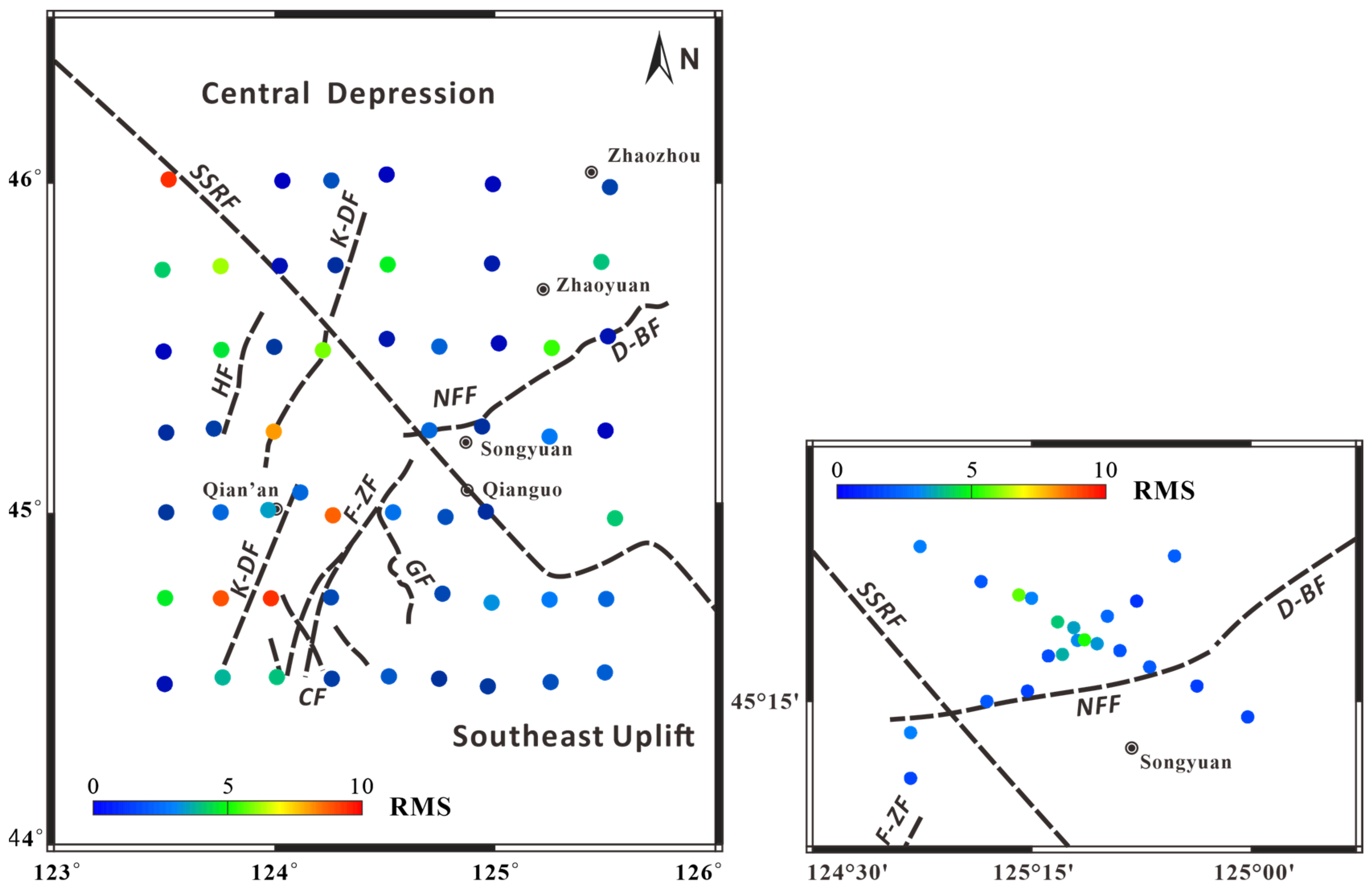
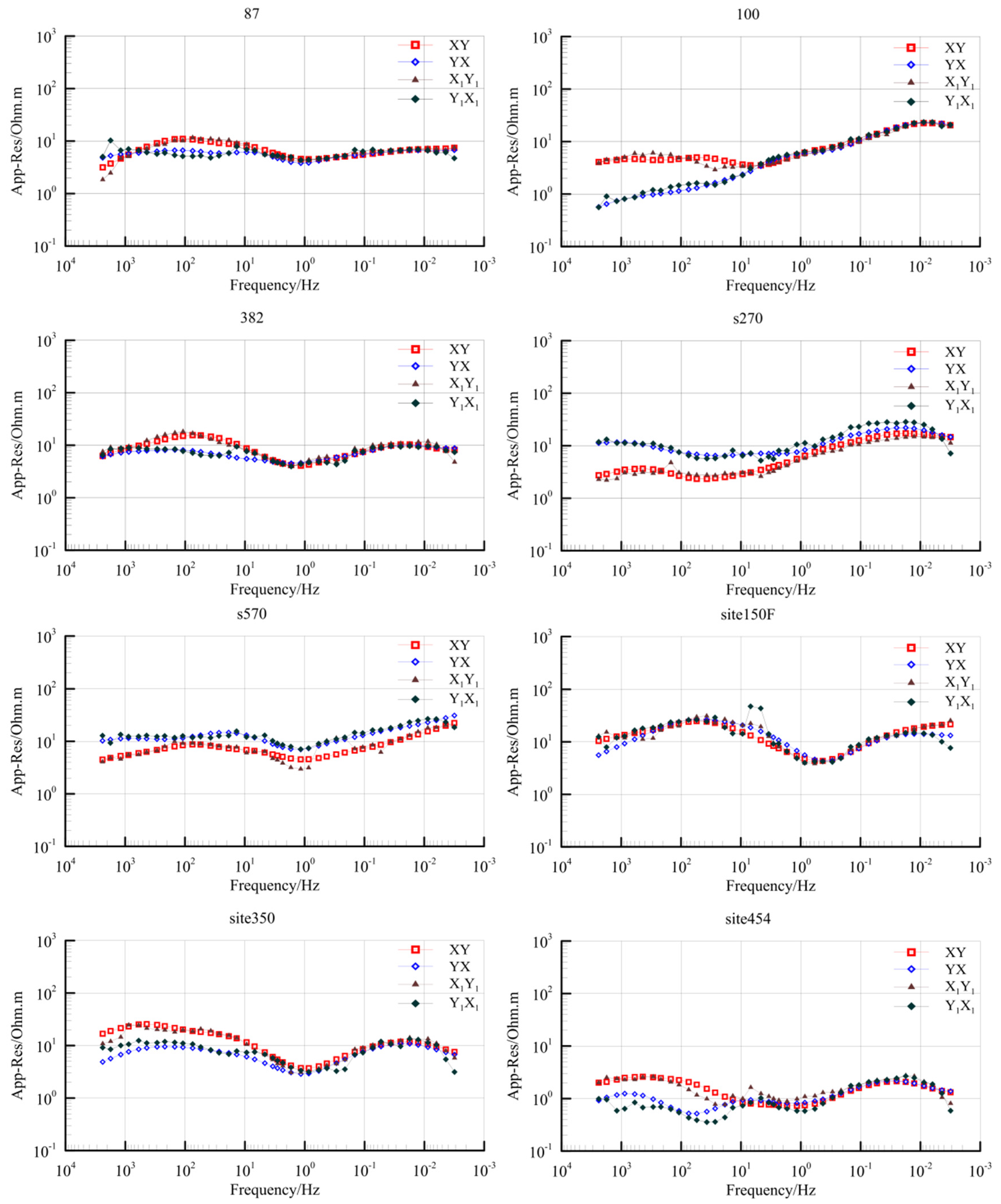
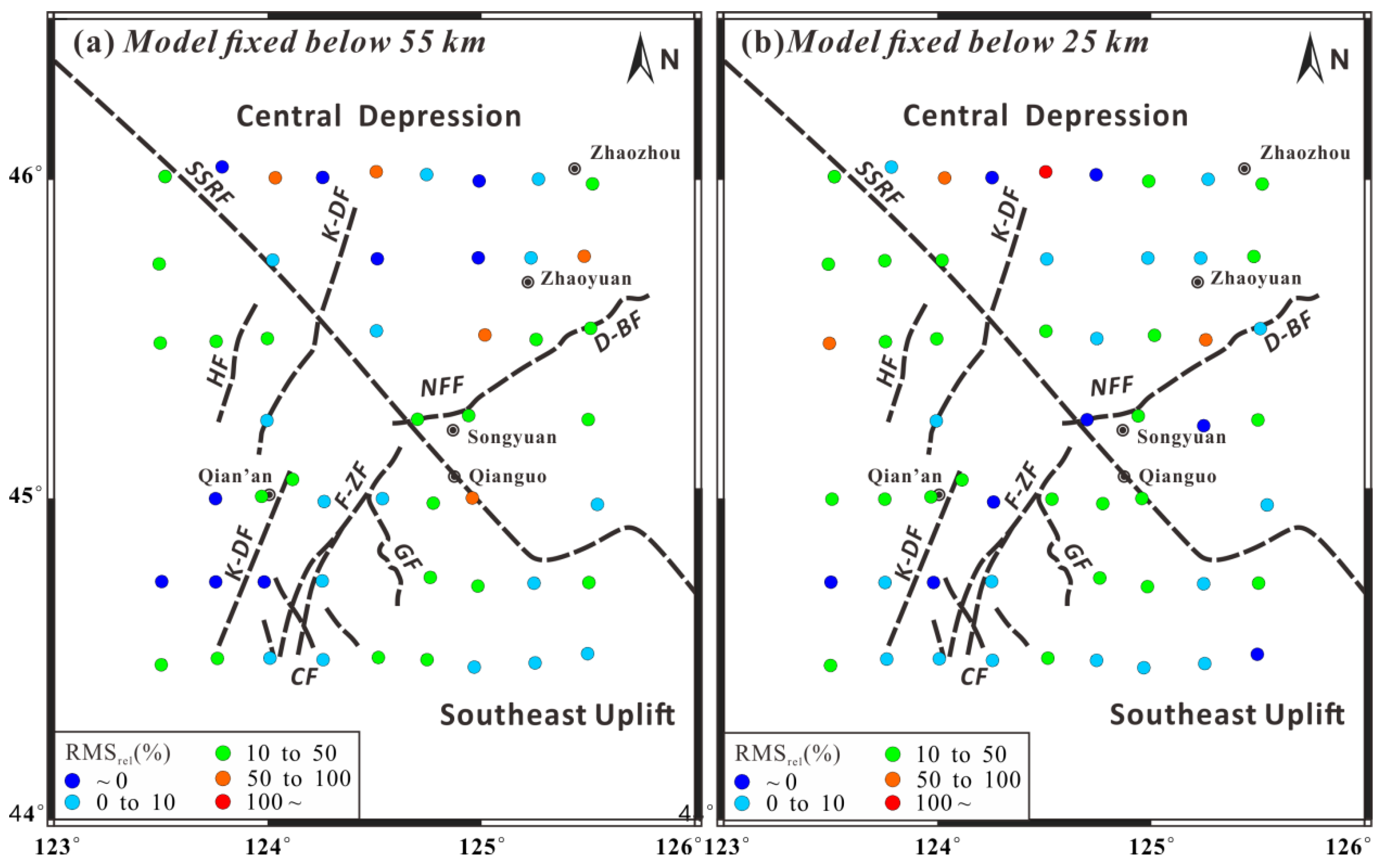
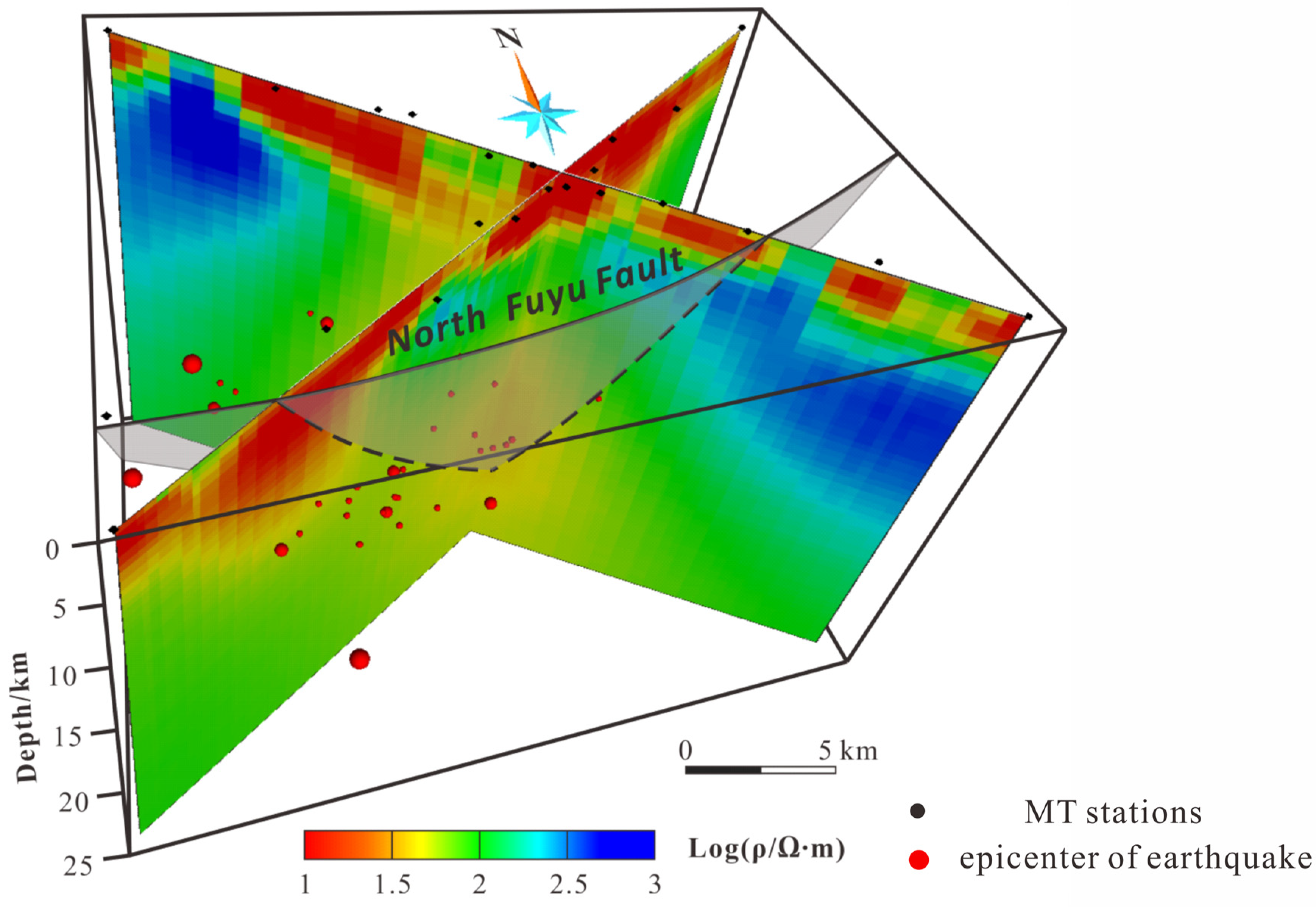
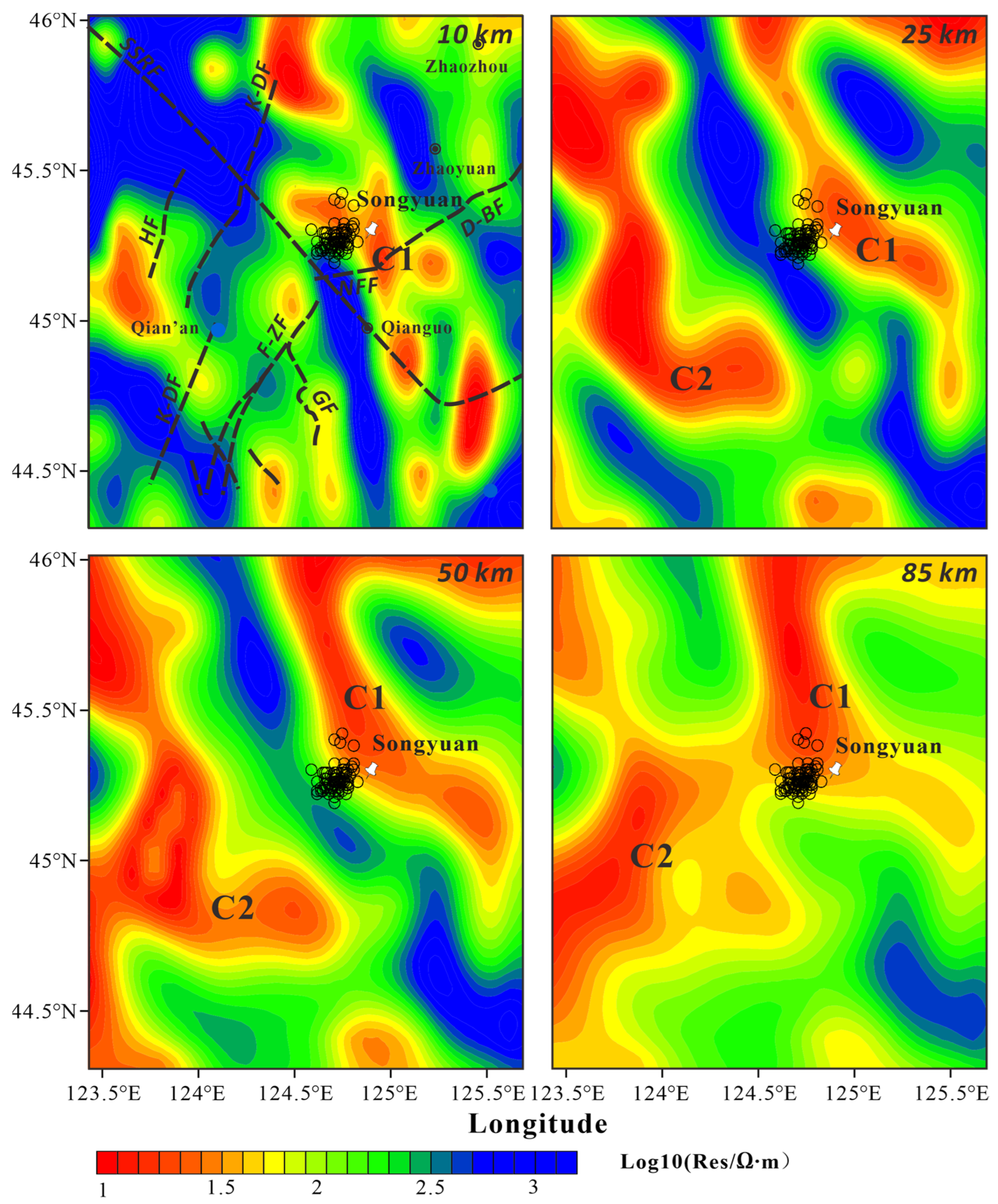
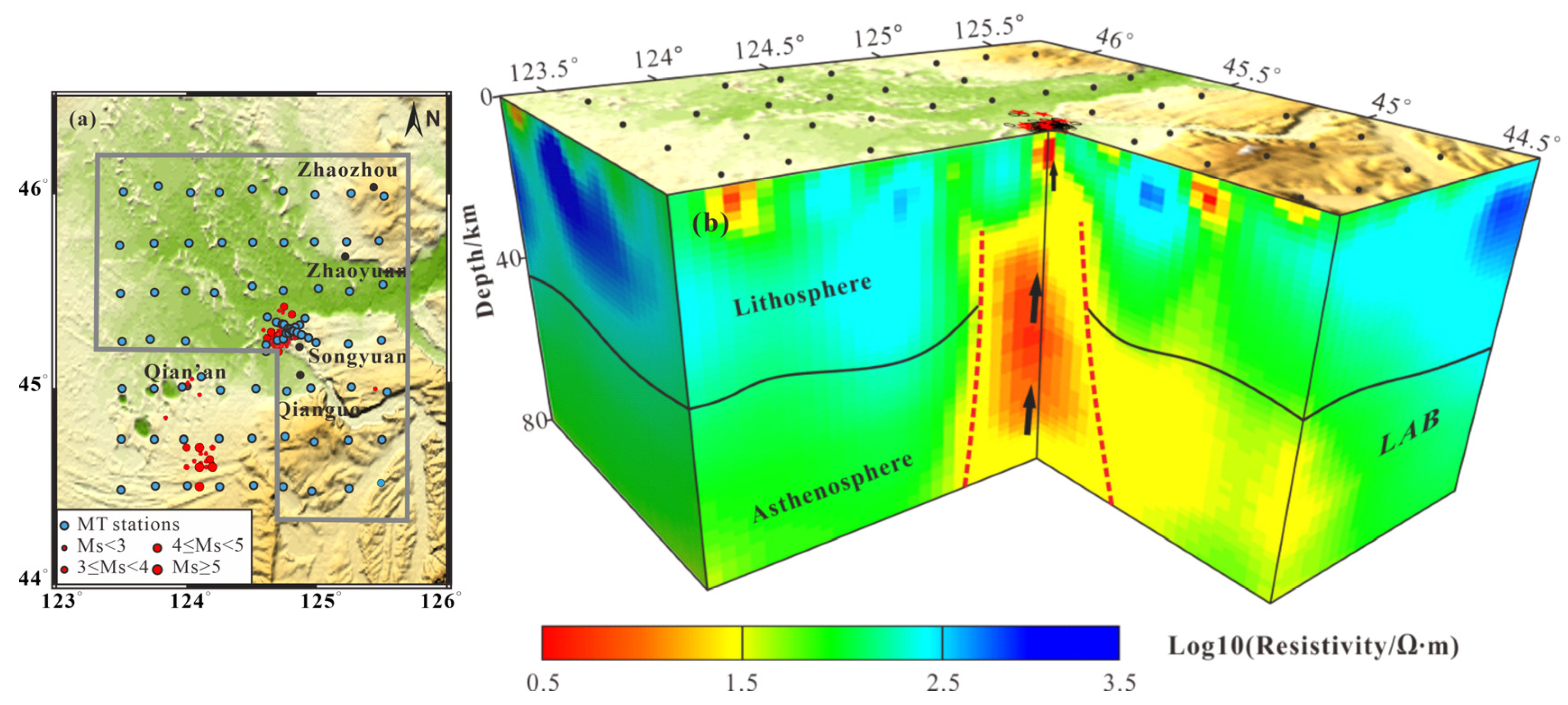
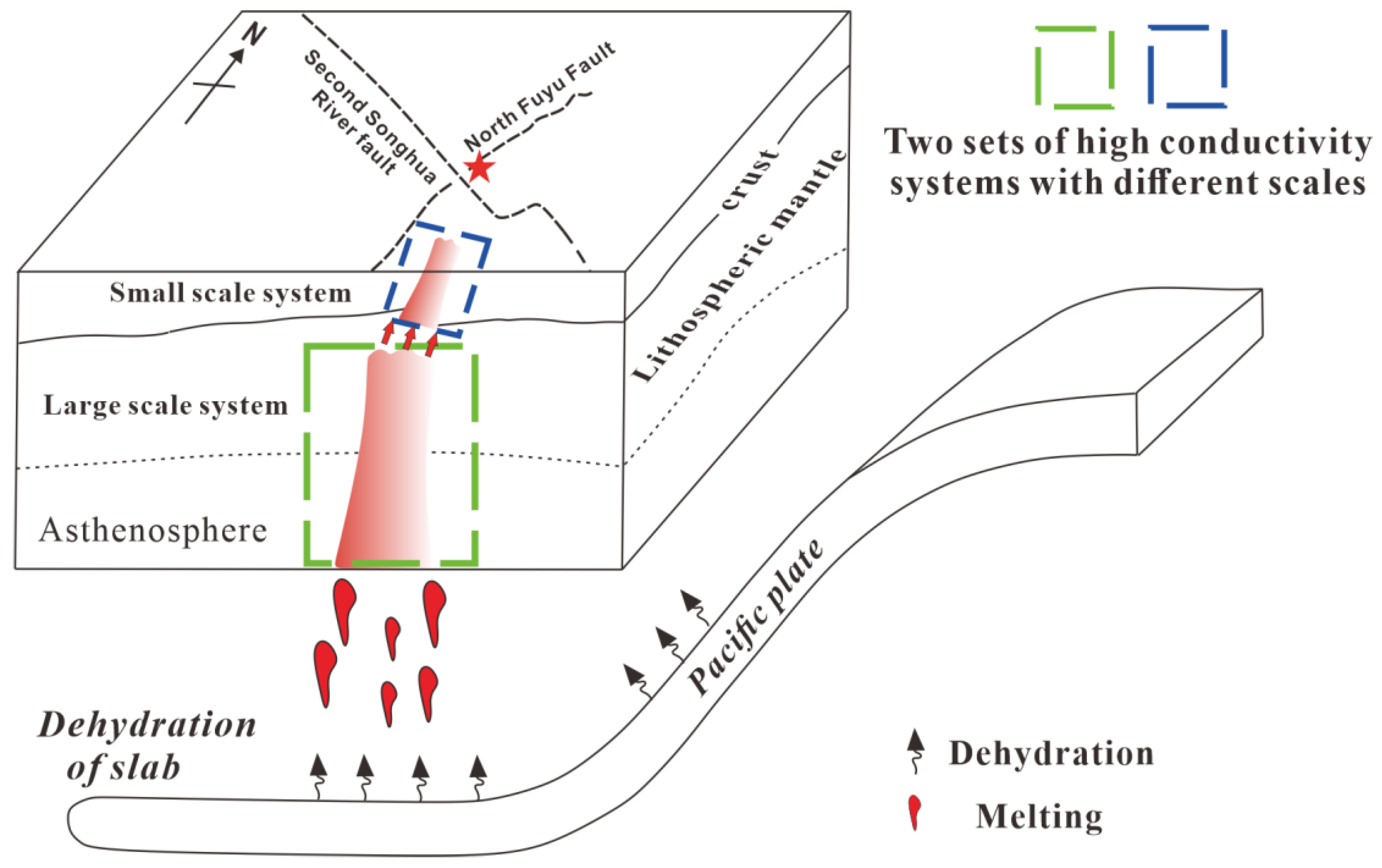
Disclaimer/Publisher’s Note: The statements, opinions and data contained in all publications are solely those of the individual author(s) and contributor(s) and not of MDPI and/or the editor(s). MDPI and/or the editor(s) disclaim responsibility for any injury to people or property resulting from any ideas, methods, instructions or products referred to in the content. |
© 2024 by the authors. Licensee MDPI, Basel, Switzerland. This article is an open access article distributed under the terms and conditions of the Creative Commons Attribution (CC BY) license (https://creativecommons.org/licenses/by/4.0/).
Share and Cite
Jia, X.; Li, Z.; Han, J.; Hou, H.; Xin, Z.; Liu, L.; Liu, W. Two Sets of High-Conductivity Systems with Different Scales Reveal the Seismogenic Mechanism of Earthquakes in the Songyuan Area, Northeastern China. Remote Sens. 2024, 16, 547. https://doi.org/10.3390/rs16030547
Jia X, Li Z, Han J, Hou H, Xin Z, Liu L, Liu W. Two Sets of High-Conductivity Systems with Different Scales Reveal the Seismogenic Mechanism of Earthquakes in the Songyuan Area, Northeastern China. Remote Sensing. 2024; 16(3):547. https://doi.org/10.3390/rs16030547
Chicago/Turabian StyleJia, Xiaodong, Zhuoyang Li, Jiangtao Han, Hesheng Hou, Zhonghua Xin, Lijia Liu, and Wenyu Liu. 2024. "Two Sets of High-Conductivity Systems with Different Scales Reveal the Seismogenic Mechanism of Earthquakes in the Songyuan Area, Northeastern China" Remote Sensing 16, no. 3: 547. https://doi.org/10.3390/rs16030547
APA StyleJia, X., Li, Z., Han, J., Hou, H., Xin, Z., Liu, L., & Liu, W. (2024). Two Sets of High-Conductivity Systems with Different Scales Reveal the Seismogenic Mechanism of Earthquakes in the Songyuan Area, Northeastern China. Remote Sensing, 16(3), 547. https://doi.org/10.3390/rs16030547







